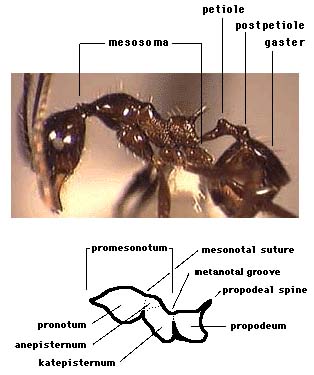
| Species List | Identification Tools |
Workers are dimorphic, with discrete minor and major (soldier) castes.

The antenna always has a discrete, three segmented club. Most species have 12 antennal segments, including the scape and club. One very tiny species that nests beneath epiphytes in the canopy of lowland wet forest has 10 segmented antennae. One small species that nests in the soil has 11 segmented antennae. Minor workers never have antennal scrobes (grooves into which the scapes fit).

A postpetiole is present. The postpetiole attaches to the gaster anteriorly, not dorsally (i.e., not Crematogaster). The metanotal groove is always distinct, such that the dorsal profile is always differentiated into at least two regions. In other words, the dorsal profile of mesosoma never forms a single convexity or unbroken curve.

Helpful measurements are head length (HL), head width (HW), scape length (SL), and Webers length (WL). Head length and head width are measured in "full face view," which means the head is tilted such that the width and length are maximized. In practice this is done by assuring that when one edge of the head is sharply in focus, the same part of the opposite edge is also in focus, and the anterior edge of the clypeus is in the same focal plane with the posteriormost margin of the head. Head length is measured as maximum length along the sagittal axis (midline). If the posterior margin of the head is cordate (concave in the middle) the measurement still begins on the midline at a point level with the rearmost projection of the vertex margin. Likewise if the clypeus is emarginate (concave medially) the measurement extends to a point level with the anteriormost projection on either side. Imagine a horizontal line, perpendicular to the sagittal axis, dropping until if first touches the rearmost projection of the head, and continuing until it last touches any part of the anterior border of the head capsule. The distance the line traveled is the head length. Head width is maximum width of the head capsule, not including the eyes (the definition of head width varies among taxonomic works, depending on whether or not the eyes are included). The entire scape is composed of a ball that is part of a ball and socket joint at the attachment point, a thin connecting piece (the radicle), and then the main shaft. The main shaft is always sharply differentiated from the radicle by a rim or flange. Scape length is the maximum length of the main shaft, excluding the radicle. Useful indices are cephalic index (CI=100*HW/HL) and scape index (SI=100*SL/HW). Webers length is measured from the anterodorsal margin of the pronotum (not including the "neck" that projects forward from the main convexity of the pronotum) to the posteroventralmost extension of the mesosoma (the metapleural lobes). Webers length is a good general measure of size, and identification tools may list species sorted by Webers length.

The dorsal profile varies in the degree of impression of the mesonotal suture. Propodeal spines vary in size. Surface sculpture of the face, mesosoma, and gaster may be smooth and shining, uniformly foveolate, or variously wrinkled ("rugose"). "Striae" are straight, sharp, elevated ridges. Pilosity (hairiness) on the mesosomal dorsum and gaster may be abundant, sparse, or absent. Setae (hairs) may be short or long, stiff or flexuous, erect to decumbent or appressed.
Figure showing face views of two constrasting Pheidole species. One has short scapes and a foveolate face. The other has long scapes and a shiny face.
Figure showing lateral views of a variety of Pheidole species. Note variation in dorsal profile and size of propodeal spines.
The hypostomal margin of majors is the lower margin of the head capsule, beneath the mandibles. Assuming a prognathous head, the margin often forms a flat to curved, perpendicular shelf. This margin bears pairs of teeth that vary among species. A pair of teeth that flank the bases of the mandibles is nearly always present, and varies little among species. These teeth are at the dorsal edge of the shelf, and thus when the head capsule is viewed from below, these teeth are recessed relative to the ventral surface of the head, and usually inconspicuous, being back in the shadow of the buccal cavity and appressed to the base of the mandibles. The ventral margin of this shelf bears teeth that vary greatly among species, and thus are useful in identification. When present, these teeth are conspicuous on the anteroventral margin of the head when viewed from below. They vary in position, from closely spaced near the midline to widely spaced. When widely spaced, they may overlap and obscure the recessed teeth behind them. The middle of the anteroventral margin often has a low tooth or tubercle.

The figures below show two examples of the hypostomal margin, ventral view. In the top figure, the ventral teeth are widely separated, and they are sharp and spiniform. In the lower figure, the teeth are closely spaced, subtriangular, and there is a median tooth.

Page author: John T. Longino longinoj@evergreen.edu
Last modified: 26 July 2005.